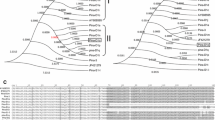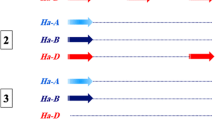Abstract
Puroindolines (puroindoline a and puroindoline b) determine the texture of the wheat grain, which affects milling properties of the grain and water absorption properties of the flour. The level of common wheat hardness is controlled by the allelic composition at the Ha locus on the short arm of chromosome 5D, which contains the closely linked Pina-D1 and Pinb-D1 genes. Aegilops species can be a source of novel variants of puroindoline genes for enriching the wheat gene pool. Among them is the tetraploid species Ae. biuncialis Vis. (UUMM). In our study, the polymorphism of puroindoline gene length was analyzed in Ae. biuncialis using PCR amplification with gene-specific primers. We analyzed a collection of Ae. biuncialis accessions originating from the Crimean Peninsula. Polymorphism with respect to the number of amplicons produced with gene-specific primers to the puroindoline b gene was revealed: there were one (about 520 bp) or two amplification products (about 520 and 500 bp). The frequency of accessions with two amplicons in the collection was 12.5%. Samples with two amplicons were found in the eastern and southern parts of the area of the species on the Crimean Peninsula. Probably, in the Ae. biuncialis accessions with two amplicons, the fragment of about 520 bp corresponds to the Pinb-U1 gene; the 500-bp fragment, to the Pinb-M1 gene, and this allele may be similar to the rare Pinb-M1-III allele of Ae. comosa.



Similar content being viewed by others
REFERENCES
Chantret, N., Salse, J., Sabot, F., et al., Molecular basis of evolutionary events that shaped the hardness locus in diploid and polyploid wheat species (Triticum and Aegilops), Plant Cell, 2005, vol. 17, no. 4, pp. 1033–1045. https://doi.org/10.1105/tpc.104.029181
Chen, M., Wilkinson, M., Tosi, P., et al., Novel puroindoline and grain softness protein alleles in Aegilops species with the C, D, S, M and U genomes, Theor. Appl. Ge-net., 2005, vol. 111, no. 6, pp. 1159–1166. https://doi.org/10.1007/s00122-005-0047-7
Cuesta, S., Guzmán, C., and Alvarez, J.B., Allelic diversity and molecular characterization of puroindoline genes in five diploid species of the Aegilops genus, J. Exp. Bot., 2013, vol. 64, no. 16, pp. 5133–5143. https://doi.org/10.1093/jxb/ert299
Dulai, S., Molnár, I., Szopkó, D., et al., Wheat-Aegilops biuncialis amphiploids have efficient photosynthesis and biomass production during osmotic stress, J. Plant Physiol., 2014, vol. 171, pp. 509–517. https://doi.org/10.1016/j.jplph.2013.11.015
Farkas, A., Molnár, I., Dulai, S., et al., Increased micronutrient content (Zn, Mn) in the 3Mb(4B) wheat – Aegilops biuncialis substitution and 3Mb.4BS translocation identified by GISH and FISH, Genome, 2014, vol. 57, pp. 61–67. https://doi.org/10.1139/gen-2013-0204
Gautier, M.F., Aleman, M.E., Guirao, A., et al., Triticum aestivum puroindolines, two basic cysteine-rich seed proteins: cDNA sequence analysis and developmental gene expression, Plant Mol. Biol., 1994, vol. 25, pp. 43–57. https://doi.org/10.1007/BF00024197
Ivanizs, L., Marcotuli, I., Rakszegi, M., et al., Identification of new QTLs for dietary fiber content in Aegilops biuncialis, Int. J. Mol. Sci., 2022, vol. 23, no. 7, p. 3821. https://doi.org/10.3390/ijms23073821
Kozub, N.A., Sozinov, I.A., Xynias, I.N., et al., Allelic variation at high-molecular-weight glutenin subunit loci in Aegilops biuncialis Vis., Russ. J. Genet., 2011, vol. 47, no. 9, pp. 1078–1083. https://doi.org/10.1134/S1022795411090092
Kozub, N.A., Sozinov, I.A., and Sozinov, A.A., Identification of alleles at the gliadin loci Gli-U1 and Gli-Mb1 in Aegilops biuncialis Vis., Russ. J. Genet., 2012, vol. 48, no. 4, pp. 390–395. https://doi.org/10.1134/S1022795412030052
Kumar, S., Stecher, G., Li, M., et al., MEGA X: Molecular Evolutionary Genetics Analysis across computing platforms, Mol. Biol. Evol., 2018, vol. 35, pp. 1547–1549. https://doi.org/10.1093/molbev/msy096
Kumar, A., Kapoor, P., Chunduri, V., et al., Potential of Aegilops sp. for improvement of grain processing and nutritional quality in wheat (Triticum aestivum), Front. Plant Sci., 2019, vol. 10, p. 308. https://doi.org/10.3389/fpls.2019.00308
Massa, A. and Morris, C.F., Molecular evolution of the puroindoline-a, puroindoline-b, and grain softness protein-1 genes in the tribe Triticeae, J. Mol. Evol., 2006, vol. 63, no. 4, pp. 526–536. https://doi.org/10.1093/molbev/msp076
Massa, A., Morris, C.F., and Gill, B.S., Sequence diversity of Puroindoline-a, Puroindoline-b, and the grain softness protein genes in Aegilops tauschii Coss, Crop Sci., 2004, vol. 44, no. 5, pp. 1808–1816. https://doi.org/10.2135/cropsci2004.1808
Molnár, I., Gaspar, L., Savari, E., et al., Physiological and morphological responses to water stress in Aegilops biuncialis and Triticum aestivum genotypes with differing tolerance to drought, Funct. Plant Biol., 2004, vol. 31, pp. 1149–1159. https://doi.org/10.1071/FP03143
Monte, J.V., De Nova, P.J.G., and Soler, C., AFLP-based analysis to study genetic variability and relationships in the Spanish species of the genus Aegilops, Hereditas, 2001, vol. 135, pp. 233–238. https://doi.org/10.1111/j.1601-5223.2001.00233.x
Morris, C.F., The antimicrobial properties of the puroindolines, a review, World J. Microbiol. Biotechnol., 2019, vol. 35, no. 6, p. 86. https://doi.org/10.1007/s11274-019-2655-4
Morris, C.F., Puroindolines: the molecular genetic basis of wheat grain hardness, Plant Mol. Biol., 2002, vol. 48, nos. 5–6, pp. 633–647. https://doi.org/10.1023/a:1014837431178
Morris, C.F., Luna, J., and Caffe-Treml, M., The Vromindolines of cv. Hayden oat (Avena sativa L.) – A review of the Poeae and Triticeae indolines and a suggested system for harmonization of nomenclature, J. Cereal Sci., 2021, vol. 97, p. 103135. https://doi.org/10.1016/j.jcs.2020.103135
Okada, M., Ikeda, T.M., Yoshida, K., et al., Effect of the U genome on grain hardness in nascent synthetic hexaploids derived from interspecific hybrids between durum wheat and Aegilops umbellulata, J. Cereal Sci., 2018, vol. 83, pp. 153–161. https://doi.org/10.1016/j.jcs.2018.08.011
Okada, M., Michikawa, A., Yoshida, K., et al., Phenotypic effects of the U-genome variation in nascent synthetic hexaploids derived from interspecific crosses between durum wheat and its diploid relative Aegilops umbellulata, PLoS One, 2020, vol. 15, no. 4, p. 0231129. https://doi.org/10.1371/journal.pone.0231129
Okuno, K., Ebana, K., Noov, B., et al., Genetic diversity and Central Asian and north Caucasian Aegilops species as revealed by RAPD markers, Genet. Res. Crop. Evol., 1998, vol. 45, pp. 389–394. https://doi.org/10.1023/A:1008660001263
Pauly, A., Pareyt, B., Fierens, E., et al., Wheat (Triticum aestivum L. and T. turgidum L. ssp. durum) kernel hardness: I. Current view on the role of puroindolines and polar lipids, Compr. Rev. Food Sci. Food Saf., 2013, vol. 12, pp. 413–426. https://doi.org/10.1111/1541-4337.12018
Rabokon, A., Demkovych, A., Sozinov, A., et al., Intron length polymorphism of β-tubulin genes of Aegilops biuncialis Vis, Cell Biol. Int., 2019, vol. 43, no. 9, pp. 1031–1039. https://doi.org/10.1002/cbin.10886
Rakszegi, M., Molnár, I., Lovegrove, A., et al., Addition of Aegilops U and M chromosomes affects protein and dietary fiber content of wholemeal wheat flour, Front. Plant Sci., 2017, vol. 8, p. 1529. https://doi.org/10.3389/fpls.2017.01529
Shewry, P., Wheat grain proteins: past, present and future, Cereal Chem., 2022, vol. 100, no. 1, pp. 9–22. https://doi.org/10.1002/cche.10585
Slageren, M.W. van, Wild wheats: a monograph of Aegilops L. and Amblyopyrum (Jaub. & Spach) Eig (Poaceae), Wageningen: Agric. Univ. Pap., 1994.
Tan, F., Zhou, J., Yang, Z., et al., Characterization of a new synthetic wheat – Aegilops biuncialis partial amphiploid, Afr. J. Biotech., 2009, vol. 8, no. 14, pp. 3215–3218. https://doi.org/10.5897/AJB09.359
Turnbull, K.M., Turner, M., Mukai, Y., et al., The organization of genes tightly linked to the Ha locus in Aegilops tauschii, the D-genome donor to wheat, Genome, 2003, vol. 46, no. 2, pp. 330–338. https://doi.org/10.1139/g02-124
Xiaoling, M., Xue, H., Sun, J., et al., Transformation of Pinb-D1x to soft wheat produces hard wheat kernel texture, J. Cereal Sci., 2020, vol. 91, p. 102889. https://doi.org/10.1016/j.jcs.2019.102889
Zhou, J.P., Yao, C.H., Yang, E.N., et al., Characterization of a new wheat-Aegilops biuncialis addition line conferring quality-associated HMW glutenin subunits, Genet. Mol. Res., 2014, vol. 13, no. 1, pp. 660–669. https://doi.org/10.4238/2014.January.28.11
Zhou, J.P., Cheng, Y., Zang, L.L., et al., Characterization of a new wheat-Aegilops biuncialis 1Mb(1B) substitution line with good quality-associated HMW glutenin subunit, Cereal Res. Commun., 2016, vol. 44, no. 2, pp. 198–205. https://doi.org/10.1556/0806.43.2015.048
Funding
The research was supported by project 0123U100962.
Author information
Authors and Affiliations
Corresponding authors
Ethics declarations
The authors declare that they have no conflicts of interest. This article does not contain any studies involving animals or humans as objects of research.
About this article
Cite this article
Sozinova, O.I., Kozub, N.O. & Blume, Y.B. Polymorphism of Pinb-1 Gene Length in Aegilops biuncialis Vis.. Cytol. Genet. 57, 298–304 (2023). https://doi.org/10.3103/S0095452723040102
Received:
Revised:
Accepted:
Published:
Issue Date:
DOI: https://doi.org/10.3103/S0095452723040102




